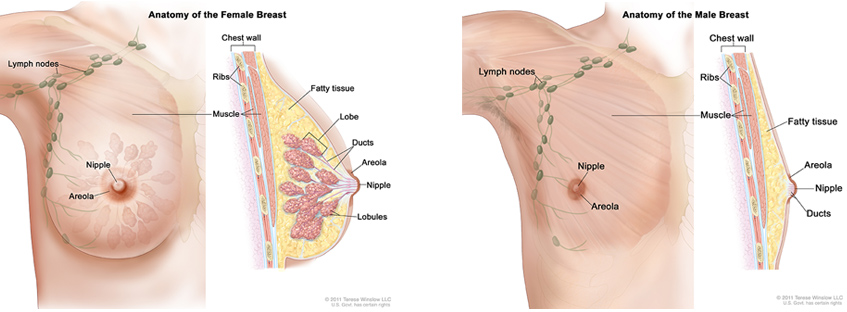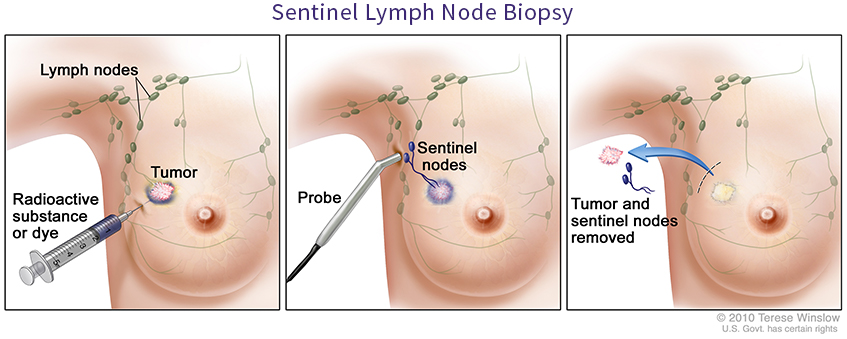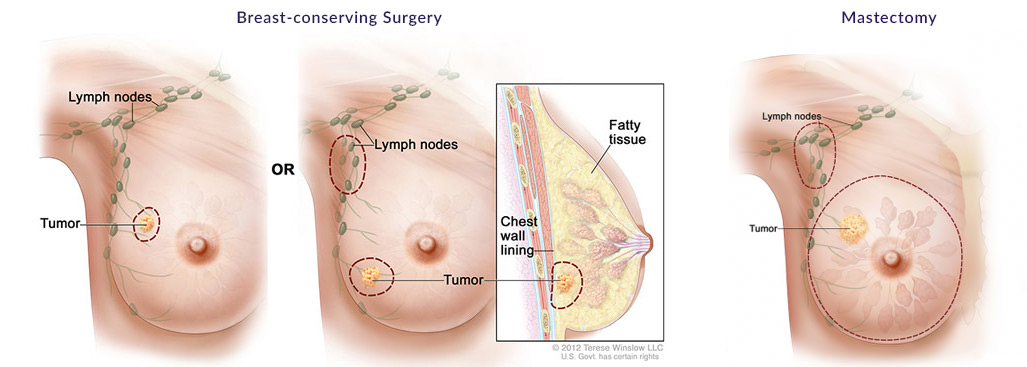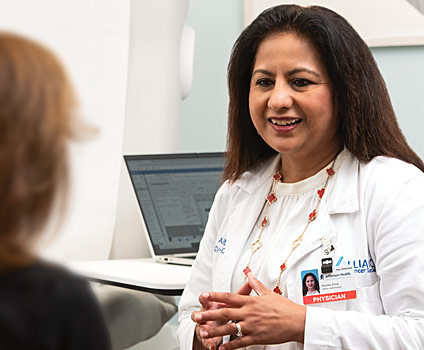About Breast Cancer
Breast cancer is cancer that begins in the breast when cells begin to grow out of control. These cells typically form a tumor which can often be seen on an X-ray or felt as a lump. A tumor is malignant, or cancerous, if the cells invade surrounding tissues or metastasize (spread) to other areas of the body. There are different types of breast cancers:
- Ductal cancers begin in the ducts that carry milk to the nipple.
- Lobular cancers start in the glands that make breast milk.
- Sarcomas and lymphomas, which are much less common, start in other tissues of the breast and are not typically considered breast cancer.

Diagnosing Breast Cancer
Symptoms of breast cancer vary, and some people don’t notice any at all. If a routine mammogram or clinical breast exam shows something abnormal, you’ll need follow-up tests, which may include a diagnostic mammogram, breast ultrasound or breast MRI. If these tests are inconclusive, you’ll need a biopsy.
A biopsy is when cells or tissue are removed from a suspicious area, then studied under a microscope. There are two types of biopsies:
Needle biopsies, usually done first, only sample a small area of cells. If needed, the next step is a surgical biopsy, which takes a larger sample. The biopsy will be sent to a pathologist, who examines the tissue, prepares a report, and gives a diagnosis. The report also includes an analysis on the type of cells involved, the aggressiveness (grade) of the cancer, and whether the cells have hormone receptors or other receptors that may influence your treatment options.

Treating Breast Cancer
Surgery – Often the first step in treatment, surgery allows your doctor to more accurately stage the cancer and determine if additional treatment is needed. There are two main types of breast cancer surgery. Breast-conserving surgery aims to remove the cancer as well as some of the surrounding tissue, without removing the entire breast. A mastectomy is the removal of the entire breast and sometimes other nearby tissues.

Radiation – Radiation therapy uses high-dose X-rays to destroy cancer cells, most often after surgery or when cancer has spread to other parts of the body. Two main types of radiation therapy can be used to treat breast cancer: external beam radiation, which comes from a machine outside the body, or internal radiation (brachytherapy), when a radioactive source is temporarily placed inside the body.
Chemotherapy – Chemotherapy (chemo) is treatment with cancer-killing drugs given through an IV or pill. Chemo can be given before surgery to shrink the size of a tumor, after surgery to kill any cancer cells that may have been left behind, or to treat advanced cancer that has spread beyond the breast and underarm area.
Hormone therapy – About two-thirds of breast cancers are hormone positive and can be treated with hormone therapy. This treatment aims to lower the amount of estrogen in the body or block estrogen from attaching to breast cancer cells.
Targeted therapy – Researchers have developed new drugs that target some of the cell changes causing cancer cells to grow out of control. These drugs are designed to seek out and kill specific cancer cells without harming healthy cells in the process.
Genetic Testing
If you are diagnosed with breast cancer, your doctor may recommend genetic testing through our Genetic Risk Evaluation and Testing (GREAT) program to see if you have an inherited gene mutation, such as BRCA1 or BRCA2. This can help you understand your risk for developing other cancers, as well as your family’s risk of developing cancer. This can also help your doctor decide on the best course of treatment as certain therapies are designed for patients with specific gene mutations.
Clinical Trials
Through US Oncology Research, one of the largest community-based oncology research programs in the US, our patients have access to the latest advancements in cancer treatment. Your doctor may recommend that you participate in a clinical trial depending on your type and stage of breast cancer.
Breast Cancer Facts
Breast cancer begins when cells in the breast grow irregularly. It is the second leading cause of cancer death among women in the United States.
 Risk Factors
Risk Factors
Gender
Women are about 100 times more likely than men to get breast cancer.
Age
Most breast cancers develop in adults over the age of 55.
Genetics
Women who have a close blood relative with breast cancer have a higher risk, as do women with inherited gene mutations such as BRCA1 and BRCA2.
Reproductive History
Women who began menstruating before 12 or experienced menopause after 55 may have an increased risk. Having a child before age 30 and/or breastfeeding can reduce the risk.
Alcohol
Consumption of alcohol can increase the risk.
Weight
Being overweight after menopause is linked to a higher risk.
Being Sedentary
Those who have sedentary lifestyles may be at a higher risk.
 Signs and Symptoms
Signs and Symptoms
Patients experiencing any of these symptoms should consult a physician.
A new lump or mass is the most common sign
Swelling of part or all of the breast
Skin irritation or dimpling
Nipple pain, nipple turning inward and/or abnormal discharge
Redness or scaliness of the nipple or breast skin
 Screening
Screening
The American Cancer Society recommends the following guidelines for the screening and early detection of breast cancer:
Women age 40 to 44 have the option to start annual mammograms
Women age 40 to 54 should get mammograms every year
Women age 55 and older can continue annual mammograms or reduce frequency to every other year
Women at a higher than average risk for breast cancer should get an MRI and mammogram every year starting at age 30
 Prevention
Prevention
Check out these prevention activities to lower your risk of breast cancer.
Don’t have that drink. Women who don’t drink have a slightly lower risk than those who have one drink every day.
Stay fit. Maintaining a physically active lifestyle and staying at a healthy weight can reduce your risk.
Talk to your doctor about birth control. The hormones in birth control may slightly increase your risk.
If it’s in your life plan, have children. Studies have shown that women who bear children before 30 have a lower risk.

 When Kim was diagnosed with stage 4 serous carcinoma ovarian cancer on August 9, 2022, she was hospitalized at St. Mary’s—an overwhelming start to a life-changing journey. But from the very beginning, one constant stood out: her connection with Dr. Krista Isaac. “She’s been more than just my oncologist,” Kim said. “She’s been a constant source of comfort, someone who listens to my fears, answers every question, and truly looks out for me.”
When Kim was diagnosed with stage 4 serous carcinoma ovarian cancer on August 9, 2022, she was hospitalized at St. Mary’s—an overwhelming start to a life-changing journey. But from the very beginning, one constant stood out: her connection with Dr. Krista Isaac. “She’s been more than just my oncologist,” Kim said. “She’s been a constant source of comfort, someone who listens to my fears, answers every question, and truly looks out for me.”